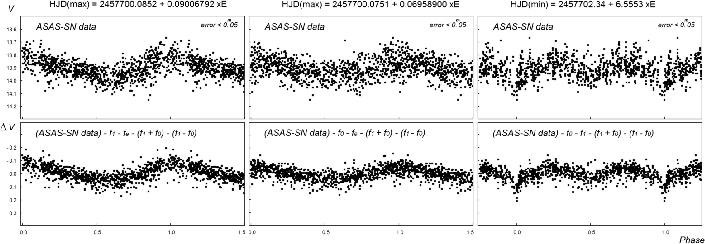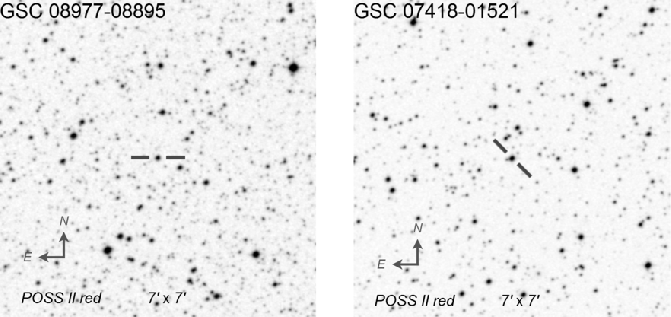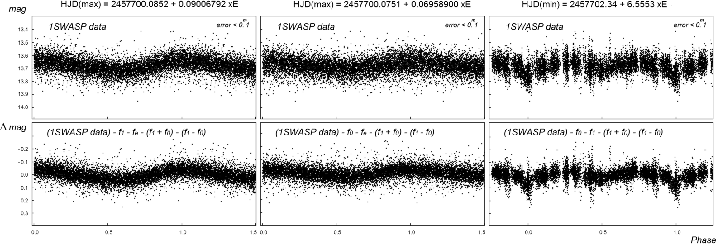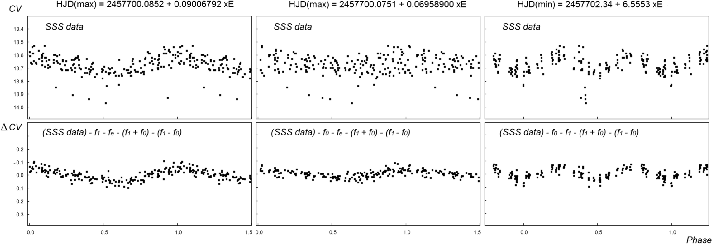|
Peremennye Zvezdy (Variable Stars) 40, No. 13, 2020 Received 17 December; accepted 20 December. |
Article in PDF |
|
DOI: 10.24411/2221-0474-2020-10015
|
Variability of GSC 08977-08895 and GSC 07418-01521
A. V. Khruslov1,2
![]() Sternberg Astronomical Institute, Moscow State
University, Universitetsky pr. 13, 119992, Moscow,
Sternberg Astronomical Institute, Moscow State
University, Universitetsky pr. 13, 119992, Moscow,
Russia;
e-mail: khruslov@bk.ru
![]() Institute of Astronomy, Russian Academy of Sciences,
Pyatnitskaya Str. 48, 119017, Moscow, Russia
Institute of Astronomy, Russian Academy of Sciences,
Pyatnitskaya Str. 48, 119017, Moscow, Russia
|
I present a study of two variable stars, GSC
08977-08895 and GSC 07418-01521. This study is a part of our
search for double-mode and multi-mode periodicity of variables.
GSC 08977-08895 shows variability of a Doubly Eclipsing System,
type ELL+EA. GSC 07418-01521 is a high-amplitude double-mode
|
1. Introduction
In this paper, I present a study of two variable stars, GSC
08977-08895 and GSC 07418-01521. Our search for double-mode and
multi-mode periodicity among RR Lyrae and ![]() Scuti variables
in the ASAS-SN Catalog of Variable
Stars1 (Jayasinghe et
al., 2019) resulted in detection of additional brightness
variations of these two stars. GSC 08977-08895 is a Doubly
Eclipsing System (type ELL+EA in the GCVS catalog classification,
Samus et al., 2017), similar to the systems detected by the author
(Khruslov, 2018) and earlier, by the OGLE team in the Galactic
disk fields (Pietrukowicz et al., 2013) and in the Galactic bulge
(Soszynski et al., 2016). GSC 07418-01521 is a rare case of a
high-amplitude double-mode
Scuti variables
in the ASAS-SN Catalog of Variable
Stars1 (Jayasinghe et
al., 2019) resulted in detection of additional brightness
variations of these two stars. GSC 08977-08895 is a Doubly
Eclipsing System (type ELL+EA in the GCVS catalog classification,
Samus et al., 2017), similar to the systems detected by the author
(Khruslov, 2018) and earlier, by the OGLE team in the Galactic
disk fields (Pietrukowicz et al., 2013) and in the Galactic bulge
(Soszynski et al., 2016). GSC 07418-01521 is a rare case of a
high-amplitude double-mode ![]() Scuti variable, pulsating in
the fundamental mode and the first overtone mode, with an
eclipsing component (type HADS(B)+EA, or DSCT(B)+EA in the
classification scheme of the GCVS). In both cases, the double
periodicity cannot be explained with a blend of two variable
sources. Both stars are single photometric objects, very well
identified in the ASAS-SN data.
Scuti variable, pulsating in
the fundamental mode and the first overtone mode, with an
eclipsing component (type HADS(B)+EA, or DSCT(B)+EA in the
classification scheme of the GCVS). In both cases, the double
periodicity cannot be explained with a blend of two variable
sources. Both stars are single photometric objects, very well
identified in the ASAS-SN data.
Our photometric study of both stars is based mainly on data of the All-Sky Automated Survey for Supernovae, ASAS-SN2(Shappe et al., 2014; Kochanek et al., 2017). Additionally, I used all observations available for these stars in the All Sky Automated Survey, ASAS-33(Pojmanski, 2002), the Wide Angle Search for Planets, 1SWASP4 (Butters et al., 2010), and Siding Spring Survey from the Catalina Sky Surveys, SSS5(Drake et al., 2009) online public archives. The 1SWASP observations are available as FITS tables, which were converted into ASCII tables using the OMC2ASCII program as described by Sokolovsky (2007); we also used the SuperWASP FITS to ASCII lightcurve conversion service6.
I analyzed all the observations using Deeming's method (Deeming, 1975) and Lafler-Kinman method (Lafler & Kinman, 1965) implemented in the WinEfk code7 written by V.P. Goranskij.
The stars were identified in the USNO-B1.0 (Monet et al., 2003) and GSC (Morrison et al., 2001) catalogs. The coordinates of the variables were drawn from the Gaia DR2 catalog (Gaia Collaboration, Brown et al., 2018).
The photometric data used in my study are available online in the
html version of this paper as a zip-archive . Symbols after star
numbers in the names of data files correspond to the photometry
source: "a" stands for ASAS-SN ![]() -band data; "a3", for ASAS-3
observations; "s", for Catalina SSS data; and"w" designates
data from the 1SWASP survey. Figure 1 presents the finding charts.
-band data; "a3", for ASAS-3
observations; "s", for Catalina SSS data; and"w" designates
data from the 1SWASP survey. Figure 1 presents the finding charts.
2. GSC 08977-08895
The variability of GSC 08977-08895 = USNO-B1.0 0278-0392959,
RA(J2000) =
11![]() 47
47![]() 11
11![]() 56, Dec(J2000) =
-62
56, Dec(J2000) =
-62![]() 08
08![]() 47
47
![]() 3, was announced in the GDS catalog
(Hackstein et al., 2015). The variable was designated as
GDS_J1147115-620847, its variability type and light elements were
not given; the full amplitude was 0
3, was announced in the GDS catalog
(Hackstein et al., 2015). The variable was designated as
GDS_J1147115-620847, its variability type and light elements were
not given; the full amplitude was 0![]() 26 and the median
magnitude, 12
26 and the median
magnitude, 12![]() 50 in the Sloan
50 in the Sloan ![]() band. Later, in The ASAS-SN
Catalog of Variable Stars (Jayasinghe et al., 2019), the variable
was classified as an RR Lyrae star (RRc type) with the light
elements HJD(max)
band. Later, in The ASAS-SN
Catalog of Variable Stars (Jayasinghe et al., 2019), the variable
was classified as an RR Lyrae star (RRc type) with the light
elements HJD(max)
![]() , mean
magnitude 12
, mean
magnitude 12![]() 56, and amplitude 0
56, and amplitude 0![]() 19 in Johnson's
19 in Johnson's ![]() band.
band.
I detected two components of the star's variability using the
ASAS-SN data. GSC 08977-08895 is a doubly eclipsing system, the
primary component shows an ellipsoidal variability (or EW-type
eclipsing variations), the secondary component exhibits Algol-type
variability. The variation range in the ASAS-SN data is ![]() (
(![]() ). The light elements of the detected variations are:
). The light elements of the detected variations are:
Component 1 (ELL or EW type):
Component 2 (EA type):
To improve the light elements, we used ASAS-3 data.
For component 1, the depth of primary minimum is 0![]() 14; the
difference of minimum depths,
14; the
difference of minimum depths,
![]() .
The classification as an ellipsoidal or eclipsing variable
(opposed to RR Lyrae) is based on the fact that no asymmetry of
the light curve is detected (for the twice shorter period, the
asymmetry parameter is
.
The classification as an ellipsoidal or eclipsing variable
(opposed to RR Lyrae) is based on the fact that no asymmetry of
the light curve is detected (for the twice shorter period, the
asymmetry parameter is
![]() ). For component 2, the
depth of primary minimum is 0
). For component 2, the
depth of primary minimum is 0![]() 14; the difference of minimum
depths,
14; the difference of minimum
depths,
![]() ; the eclipse duration is
; the eclipse duration is
![]() .
.
The color indices are: ![]() (2MASS; Skrutskie et al.,
2006);
(2MASS; Skrutskie et al.,
2006); ![]() (APASS8). The
light curves of GSC 08977-08895 according to ASAS-SN data are
displayed in Fig. 2.
(APASS8). The
light curves of GSC 08977-08895 according to ASAS-SN data are
displayed in Fig. 2.
3. GSC 07418-01521
The variability of GSC 07418-01521 = USNO-B1.0 0544-0769983,
RA(J2000) =
19![]() 11
11![]() 59
59![]() 02, Dec(J2000) =
-35
02, Dec(J2000) =
-35![]() 35
35![]() 26
26
![]() 7, was announced in the ASAS-SN Catalog of
Variable Stars (Jayasinghe et al., 2019). The variable was
designated as ASASSN-V J191159.03-353526.5, type HADS with the
following light elements:
7, was announced in the ASAS-SN Catalog of
Variable Stars (Jayasinghe et al., 2019). The variable was
designated as ASASSN-V J191159.03-353526.5, type HADS with the
following light elements:
![]() , mean magnitude 13
, mean magnitude 13![]() 89,
and amplitude 0
89,
and amplitude 0![]() 21 in Johnson's
21 in Johnson's ![]() band.
band.
Using ASAS-SN data, I detected three variability components of the
star. Later this conclusion was confirmed on the base of 1SWASP
and SSS data. GSC 07418-01521 is an eclipsing binary system; one
of its components is a double-mode high-amplitude ![]() Scuti
star, HADS(B). The range of variability in the ASAS-SN data is
Scuti
star, HADS(B). The range of variability in the ASAS-SN data is
![]() (
(![]() ). Additionally, I found the following
variability ranges in other surveys:
). Additionally, I found the following
variability ranges in other surveys:
![]() (
(![]() , 1SWASP);
, 1SWASP);
![]() (CV, SSS). In the
1SWASP data, the amplitude is underestimated due to blending of
several stars. During our analysis of the SSS data, I removed
probable erroneous observations, CV
(CV, SSS). In the
1SWASP data, the amplitude is underestimated due to blending of
several stars. During our analysis of the SSS data, I removed
probable erroneous observations, CV ![]() . The light elements
of the detected variations are:
. The light elements
of the detected variations are:
Component 1 (pulsating, fundamental mode, ![]() ):
):
Component 2 (pulsating, first overtone mode, ![]() ):
):
Component 3 (eclipsing, EA):
The period ratio of pulsation modes,
![]() , is
typical of the high-amplitude double-mode
, is
typical of the high-amplitude double-mode ![]() Scuti variables
with the fundamental mode and the first-overtone mode. Asymmetry
parameters of the phased light curve for the fundamental mode are
Scuti variables
with the fundamental mode and the first-overtone mode. Asymmetry
parameters of the phased light curve for the fundamental mode are
![]() according to all data; for the
first-overtone mode,
according to all data; for the
first-overtone mode,
![]() according to
ASAS-SN data and
according to
ASAS-SN data and
![]() according to 1SWASP and
SSS data. For the eclipsing component, the eclipse duration is
according to 1SWASP and
SSS data. For the eclipsing component, the eclipse duration is
![]() .
.
The power spectrum of GSC 07418-01521 according to ASAS-SN data is displayed in Fig. 3.
 |
Fig. 3.
The power spectrum of GSC 07418-01521
according to ASAS-SN data. The marked frequencies are those of the
fundamental ( |
Information on variability amplitudes of all the components is presented in Table 1. For pulsating modes, I give semi-amplitudes of oscillation; for the eclipsing mode, I give the depths of munuma I and II (full amplitudes), according to ASAS-SN, 1SWASP and SSS data, respectively. In the 1SWASP data, the amplitude is underestimated.
| Mode |
|
|
|
|
| Pulsating, | |
0.062 | 0.037 | 0.055 |
| Pulsating, | |
0.041 | 0.025 | 0.026 |
| Eclipsing, | MinI | 0.18 | 0.15 | |
| MinII | 0.08 | 0.05 | 0.08 |
The full amplitude of the sum of both pulsating oscillations is
0![]() 21 (
21 (![]() , ASAS-SN data). Because of the second component of
the binary system, the amplitude is possibly underestimated. This
confirms our classification of the system's pulsating component as
a high-amplitude double-mode
, ASAS-SN data). Because of the second component of
the binary system, the amplitude is possibly underestimated. This
confirms our classification of the system's pulsating component as
a high-amplitude double-mode ![]() Scuti star.
Scuti star.
The color indices are: ![]() (2MASS);
(2MASS); ![]() (APASS). GSC 07418-01521 is included in the GALEX catalogs of UV
sources (Bianchi et al., 2011) with the magnitudes FUV = 21.60,
NUV = 17.75.
(APASS). GSC 07418-01521 is included in the GALEX catalogs of UV
sources (Bianchi et al., 2011) with the magnitudes FUV = 21.60,
NUV = 17.75.
The light curves of GSC 07418-01521 according to ASAS-SN, 1SWASP,
and SSS data are displayed in Figs. 4, 5 and 6, respectively. When
deriving the light elements and plotting the light curves (bottom
panel), we also pre-whitened the two detected interaction
frequencies, ![]() and
and ![]() (periods 0
(periods 0![]() 0392575 and
0
0392575 and
0![]() 3060463, respectively).
3060463, respectively).
 |
Fig. 4.
The light curves of GSC 07418-01521
according to ASAS-SN data. Top panel: from raw data, folded with
the periods |
Acknowledgments: The author is grateful to Dr. V.P. Goranskij for providing light-curve analysis software.
References:
Bianchi, L., Herald, J., Efremova, B., et al. 2011, Astrophys. & Space Sci., 335, 161
Butters, O.W., West, R.G., Anderson, D.R., et al. 2010, Astron. & Astrophys., 520, L10
Deeming, T. J. 1975, Astrophys. & Space Sci., 36, 137
Drake, A.J., Djorgovski, S.G., Mahabal, A., et al. 2009, Astrophys. J., 696, 870
Gaia Collaboration, Brown, A.G.A., Vallenari, A., Prusti, T., et al. 2018, Astron. & Astrophys., 616, id.A1
Hackstein, M., Fein, Ch., Haas, M., et al. 2015, Astron. Nachr., 336, 590
Jayasinghe, T., Stanek, K.Z., Kochanek, C.S. et al, 2019, Mon. Not. Roy. Astron. Soc., 486, 1907
Khruslov, A.V. 2018, Perem. Zvezdy, 38, No.3
Kochanek, C.S., Shappee, B.J., Stanek, K.Z., et al. 2017, Publ. Astron. Soc. Pacific, 129, 104502
Lafler, J., Kinman, T.D. 1965, Astrophys. J. Suppl., 11, 216
Monet, D.G., Levine, S.E., Canzian, B., et al. 2003, Astron. J., 125, 984
Morrison, J.E., Roeser, S., McLean, B., et al. 2001, Astron. J., 121, 1752
Pietrukowicz, P., Mróz, P., Soszynski, I., et al., 2013, Acta Astron., 63, 115
Pojmanski, G., 2002, Acta Astron., 52, 397
Samus, N.N., Kazarovets, E.V., Durlevich, O.V., Kireeva, N.N., Pastukhova, E.N. 2017, Astron. Rep., 61, 80
Shappee, B.J., Prieto, J.L., Grupe, D., et al. 2014, Astrophys. J., 788, 48
Skrutskie, M.F., Cutri, R.M., Stiening, R. et al., 2006, Astron. J., 131, 1163
Sokolovsky, K.V. 2007, Perem. Zvezdy Prilozh., 7, No. 30
Soszynski, I., Pawlak, M., Pietrukowicz, P., et al. 2016, Acta Astron., 66, 405



